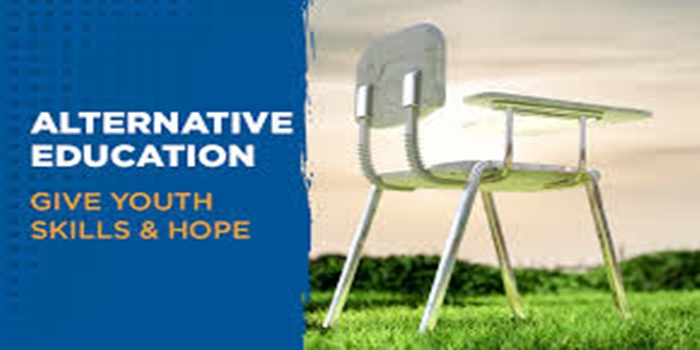In this article, we discussed the meaning of alternative education, the features, the benefits, the disadvantages and the rise.
Definition
The Rise of Alternative Education signifies a growing displeasure with traditional schooling and a movement towards more diverse, personalized, and flexible learning experiences. It reflects a recognition that not all learners thrive in the same environments and that education can be effective in various forms.
- Addressing the Needs of Diverse Learners:
Alternative education provides options for students who struggle in traditional classrooms, such as those with learning disabilities, behavioral issues, or those who are simply not suited to a structured, classroom setting.
It allows for more individualized attention, therapeutic environments, and a focus on social skills and self-esteem.
- Expanding the Definition of “School”:
Alternative education encompasses a broad range of approaches, including distance learning, homeschooling, and various non-traditional learning environments.
These environments can be online, nature-based, or even co-operative and project-based.
- Challenging Traditional Educational Paradigms:
The rise of alternative education suggests a questioning of the traditional, one-size-fits-all approach to schooling.
It emphasizes the importance of student agency, self-directed learning, and experiential education.
- Responding to Societal Changes:
The digital age and the increasing need for specialized skills have also spurred the development of alternative educational models.
Many alternative programs focus on fostering creativity, critical thinking, and problem-solving skills, which are increasingly valued in the workplace.
- Promoting Holistic Development:
Beyond academic achievement, alternative education often prioritizes the emotional, social, and physical well-being of students.
It aims to foster a love of learning and a sense of purpose, rather than simply preparing students for standardized testing.
The Features of the Rise of Alternative Education
Increased Parental Interest:
Parents are increasingly seeking more control and influence over their children’s education, leading to higher interest in school choice and alternative options like homeschooling, according to a 2024 Report on School Choice.
Diverse Educational Philosophies:
Alternative education encompasses a wide range of approaches, including Montessori, which emphasizes individual learning and exploration, and Waldorf, which focuses on holistic development and experiential learning, according to a post on Purely Pacha.
Focus on Individual Needs:
Alternative schools often prioritize the individual needs and interests of students, allowing for more flexible learning environments and individualized instruction.
Student Empowerment:
Many alternative models empower students to take an active role in their learning process, offering opportunities for self-directed learning and decision-making.
Holistic Approach:
Alternative education often takes a holistic approach to learning, encompassing academic subjects, social-emotional development, and creative expression.
Potential for Innovation and Lifelong Learning:
By fostering a love of learning and encouraging students to explore their interests, alternative education can contribute to the development of innovative thinkers and lifelong learners.
The Rise of Alternative Education offers several Benefits, including:
Specific Benefits:
Personalized Learning:
Alternative education allows students to learn at their own pace and in a way that suits their individual needs and learning styles. This can be particularly beneficial for students who struggle with traditional classroom settings or have specific learning differences.
Enhanced Student Engagement:
By offering flexible curricula, experiential learning opportunities, and a supportive environment, alternative education can increase student engagement and motivation.
Development of Essential Skills:
Many alternative programs emphasize practical skills, critical thinking, and real-world applications, preparing students for future success in various fields.
Focus on Holistic Development:
Alternative education often focuses on fostering not only academic skills but also social, emotional, and practical abilities.
Supportive and Inclusive Environment:
Alternative schools often create a more nurturing and inclusive atmosphere, where students feel safe and supported, fostering a sense of belonging.
Small Class Sizes:
Smaller class sizes in alternative schools can allow for more individualized attention and interaction between students and teachers.
Flexibility and Adaptability:
Alternative education models can be adapted to fit the needs of individual students, families, and communities.
Examples of Alternative Education:
Alternative High Schools:
These schools offer a more flexible and personalized learning experience, often catering to at-risk students or those who struggle with traditional academic settings.
Online Schools:
Online learning platforms can provide access to a wider range of educational resources and learning styles, offering flexibility for students and families.
Experiential Learning:
This approach emphasizes hands-on learning, projects, and real-world applications, allowing students to learn by doing.
Co-teaching:
This model involves two teachers working together to support students with diverse learning needs.
The Disadvantages of the Rise of Alternative Education:
Stigma and Marginalization:
Alternative schools can be perceived as “dumping grounds” or for students who don’t fit into traditional schooling. This can lead to negative perceptions and marginalization of students and staff in the alternative school.
Reduced Access to Resources:
Alternative schools may not have the same resources and opportunities as traditional schools, which could limit student access to college and career preparation.
Training and Support:
Many alternative educators may not receive the same training and support as those in traditional schools. This can lead to inconsistent practices and challenges in meeting the needs of students.
Fidelity to Original Models:
Some alternative schools may not fully adhere to the principles of their specific alternative model, leading to a diluted or less effective experience.
Unidirectional Transitions:
Once students move to an alternative school, there’s a high likelihood they won’t return to mainstream education, potentially limiting future options.
Limited College/Career Preparation:
Some alternative schools may not adequately prepare students for higher education or the workforce, which can be a significant disadvantage.
Conclusion
The rise of alternative education suggests a shift towards lifelong learning and personalized, flexible educational paths outside traditional institutions. This includes a focus on skills-based learning, online courses, and career-focused training, making education more relevant to the evolving needs of the workforce and individual learners. The conclusion is a broadened landscape of learning opportunities, catering to diverse needs and preferences.

